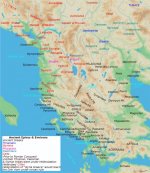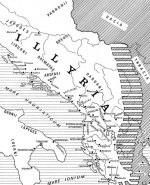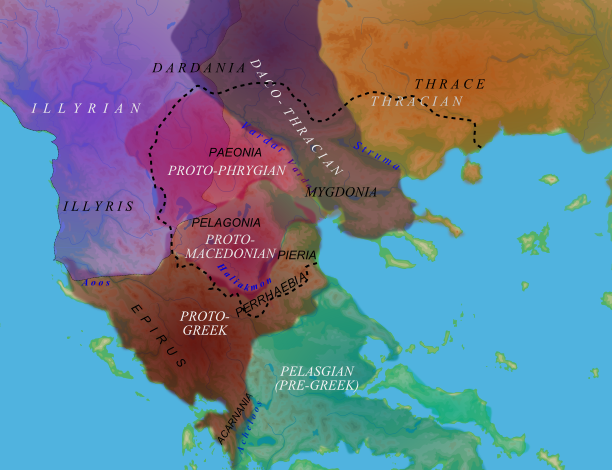Makes perfect sense, Channeled Ware influences entered Albania 1200BC, while J2b2 was already there (rumored MBA J2b sample), and then by the Iron Age they were likely Illyrianized, as Arber take their place a few hundred years later. Bryges were in Mati/Albanoi region, and then several hundred years later, Albanoi appear in their place. This Illyrian influence in the IA also stretched into Paeoni, Triballi, and Epirus. In Paeonia we see an inscription coming from Albanapolis, at Shkupi or Shtip, can't remember. We also see a similar inscription in Epirus, this is Pre-Slavic invasion, in Phoenice, today 'Finiq', also referencing coming from Albanoi region. If the Bryges were Thracians who brought Channeled Ware, it could be an early source of E-V13 in Albania & Albanians.
The Bryges were in Northern Albania, in the Mati region, where we see the Albanoi appear after some time. The Bryges also extended into Paeoni, the Sharr mountains, Shkupi. There are many links to Illyrians, Dardanians, Bryges, and Paeonians, with Albanians. Here are the Bryges in Mati, soon after they extended into Macedonia, and some went to Anatolia as the Phrygians. Here are two map below showing Brygians and Albanoi in the same spot several hundred years after Brygians are last mentioned. Were they Illyrianized? Is the name 'Arber', Illyrian, or Thracian? Why did they change their name? Were these Bryges E-V13 heavy? What happened to them? These are some questions that are worth asking. I don't have any agenda, just giving some food for thought. It's not good enough for me to conclude that Albanians are pure Illyrians or Thracians when we don't have enough data to conclude either. My views are as centered as they can be, to hear what both sides have to say with the least amount of personal bias possible. Yes, E-V13 was in Illyrians, but if some of the E-V13 in Albanians were Thracian before assimilating or fusing, why would we not want to know the source? I think the best possible candidates could be Brygians and Dardanians, this is all just food for thought, I hope no one takes it personal because I'm just giving some ideas that I think could possibly have merit.
View attachment 13407
View attachment 13408
It's not conclusive enough for me to say, that tribes like the Enchelae and Taulanti are pure Illyrians,
just because they were in Illyria, when some sources mention them coming from early Dardanians, or having channeled ware influences or cremating. Everything we read can be used as a clue. There must be some historical link there. Even Greek mythology was onto something when they said the Illyrians, Celts, and Gauls, all descend from the same peoples, they were right in Proto-Illyrians being Bell Beaker and being influenced by and competing with Celts. There are ethnic doublets from the Balkans, into Italy and Anatolia, and they shouldn't be ignored. Some may be coincidence but many will not be. There is even archeology to back this up, Balkan-material being found in Anatolia and Italy. The fact that so many ancient tribes have been regarded as both Illyrian and Thracian, near the Jiricek Line, where Proto-Albanians formed, should not be ignored. There were natural networks from Mati to Shkupi, from Lezhe to Nish, they should not be ignored.
Again just some ideas. I'm after the truth, I could care less about pushing an agenda.






